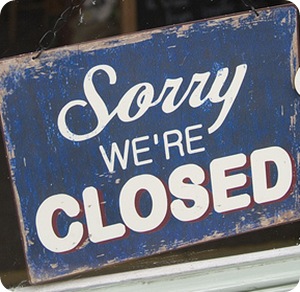
by Fronetics | Apr 7, 2015 | Blog, Leadership, Strategy
There are times when change is good. There are also times when change is bad for business.

The phrase “If it ain’t broke, don’t fix it” is often attributed to Thomas Bertram Lance, businessman and Director of the Office of Management and Budget under President Jimmy Carter. He was quoted in the May 1977 issue of the magazine Nation’s Business, though the sentiment feels as old as human existence. If something is working, and has always worked, then why change it? There are many adages along the same lines: leave well enough alone, never change a running system, don’t change a winning team.
True, humans are always evolving, but we also like consistency and stability. In his book Handbook of Contemporary Economics, Morris Altman wrote, “Without some stability over at least the short term, it is hard to conceive of humans engaging in sustained goal-oriented activity.” Change, adaptability, and flexibility, especially in business culture and lore, have turned from buzzwords to commandments. There are some things, though, that don’t require change. Assess whether change is necessary, rather than assuming it is because it’s socially and commercially popular. Ask:
- Are there assessment tools in place to monitor the business’s success?
- Are customers reporting satisfaction?
- Do your goods match customer needs?
- Do you understand the current market and your place amongst competitors?
- Are profits growing?
- Are overall finances sound?
- Are things running efficiently?
- Are current practices meeting regulations?
- Do you have the right people to meet your objectives?
- Are employees engaged, trained, and developing?
If the answer to these questions is yes, then why change? According to Harvard Business Review change could alienate your base, confuse people, damage your brand, and lose you money. Cadbury and its parent company, Kraft, are experiencing intense backlash due to a change in the Cadbury Creme Egg recipe. People are protesting, writing letters, posting negative comments online, and accusing the company of “ruining Easter.” We’ve seen this before. According to TIME’s article on the top 10 bad beverage ideas, “April 23, 1985, stands as one of the most significant dates in business history — the date the 99-year-old Coca-Cola company announced it was scrapping its original soda formula for a newer, sweeter version.” This change brought with it over 40,000 letters of protest, not to mention the bad press. Within three months the original soda formula, Coca-Cola “classic”, was back and met with an incredibly positive reception.
Some companies opt for a subtler approach to change by expanding its traditional offering. Instead of changing the successful product line for women, Dove expanded into the male market, creating Dove Men+Care, while still adhering to their public image and mission of creating personal care products that support natural health and realistic beauty.
The Harvard Business Review lists Brooks Brothers as a company that successfully found new opportunities without changing its values, “Instead of simply sticking to selling classic clothing, and waiting for outside catalysts (such as the popularity of the fashion in the television show Mad Men) to increase its popularity, the chain innovated around the edges by offering more fashionable accessories — shoes, belts, bags and the like — while leaving its core basically unchanged.” Capitalizing on this opportunity did not drive customers away because Brooks Brothers’ base products remained.
Remember that change has a cost. Are your consumers willing to pay the cost, especially if they didn’t require the change in the first place? Will your partners in the supply chain be willing to do business with you if the change you implement doesn’t suit them or benefit them? Think about some of the elements, for example, of a brand change:
- Content
- Communication
- Collateral
- Contacts
Things such as graphic design, business cards, letterhead, social media, advertising, re-launch, etc. all require real time and money. You must assess if your change will reap real, solid benefits. You don’t want to expend the effort, time, and money to change if you don’t have to, especially if it requires reversing the change or worse, killing your business.

by Fronetics | Apr 7, 2015 | Blog, Leadership, Strategy
There are times when change is good. There are also times when change is bad for business.

The phrase “If it ain’t broke, don’t fix it” is often attributed to Thomas Bertram Lance, businessman and Director of the Office of Management and Budget under President Jimmy Carter. He was quoted in the May 1977 issue of the magazine Nation’s Business, though the sentiment feels as old as human existence. If something is working, and has always worked, then why change it? There are many adages along the same lines: leave well enough alone, never change a running system, don’t change a winning team.
True, humans are always evolving, but we also like consistency and stability. In his book Handbook of Contemporary Economics, Morris Altman wrote, “Without some stability over at least the short term, it is hard to conceive of humans engaging in sustained goal-oriented activity.” Change, adaptability, and flexibility, especially in business culture and lore, have turned from buzzwords to commandments. There are some things, though, that don’t require change. Assess whether change is necessary, rather than assuming it is because it’s socially and commercially popular. Ask:
- Are there assessment tools in place to monitor the business’s success?
- Are customers reporting satisfaction?
- Do your goods match customer needs?
- Do you understand the current market and your place amongst competitors?
- Are profits growing?
- Are overall finances sound?
- Are things running efficiently?
- Are current practices meeting regulations?
- Do you have the right people to meet your objectives?
- Are employees engaged, trained, and developing?
If the answer to these questions is yes, then why change? According to Harvard Business Review change could alienate your base, confuse people, damage your brand, and lose you money. Cadbury and its parent company, Kraft, are experiencing intense backlash due to a change in the Cadbury Creme Egg recipe. People are protesting, writing letters, posting negative comments online, and accusing the company of “ruining Easter.” We’ve seen this before. According to TIME’s article on the top 10 bad beverage ideas, “April 23, 1985, stands as one of the most significant dates in business history — the date the 99-year-old Coca-Cola company announced it was scrapping its original soda formula for a newer, sweeter version.” This change brought with it over 40,000 letters of protest, not to mention the bad press. Within three months the original soda formula, Coca-Cola “classic”, was back and met with an incredibly positive reception.
Some companies opt for a subtler approach to change by expanding its traditional offering. Instead of changing the successful product line for women, Dove expanded into the male market, creating Dove Men+Care, while still adhering to their public image and mission of creating personal care products that support natural health and realistic beauty.
The Harvard Business Review lists Brooks Brothers as a company that successfully found new opportunities without changing its values, “Instead of simply sticking to selling classic clothing, and waiting for outside catalysts (such as the popularity of the fashion in the television show Mad Men) to increase its popularity, the chain innovated around the edges by offering more fashionable accessories — shoes, belts, bags and the like — while leaving its core basically unchanged.” Capitalizing on this opportunity did not drive customers away because Brooks Brothers’ base products remained.
Remember that change has a cost. Are your consumers willing to pay the cost, especially if they didn’t require the change in the first place? Will your partners in the supply chain be willing to do business with you if the change you implement doesn’t suit them or benefit them? Think about some of the elements, for example, of a brand change:
- Content
- Communication
- Collateral
- Contacts
Things such as graphic design, business cards, letterhead, social media, advertising, re-launch, etc. all require real time and money. You must assess if your change will reap real, solid benefits. You don’t want to expend the effort, time, and money to change if you don’t have to, especially if it requires reversing the change or worse, killing your business.

by Fronetics | Mar 23, 2015 | Blog, Supply Chain, Talent

What you need to know about the supply chain talent gap.
The supply chain talent gap has been called a “perfect storm.” Few topics are shrouded in such doom and gloom. Every report cites doomsday statistics of the impending crisis when, by 2025, 60 million baby boomers will exit the workforce, leaving a gigantic gap when 40 million millennials take their place. To make matters worse, the retirement exodus is only one factor contributing to the sinking ship. Future supply chain professionals need to master not only the hard analytical skills but also the soft leadership skills fueled by the transition from an industrial economy to an economy grounded in service and information. In numbers, it means only 20% of the workforce will possess the skills required of 60% of all new supply chain jobs.
But listen up, all you forward-thinking millennials and midlevel supply chain managers with cross-functional expertise. There’s some good news: The market can’t get enough of you.
Yes, amid all the dire facts, there is opportunity. There has never been a better time to be, so to speak, on the other side of the table — a college graduate or a motivated professional looking for a career with upward mobility? What other field of work can offer as much promise to new recruits and current employees as the supply chain industry?
Just as all reports predict a brewing crisis, they also tout talent management as the primary remedy. For a self-motivated individual, fresh out of college or in the midst of a corporate climb, this focus on professional development presents a smorgasbord of options. Many companies have taken note and adopted a strategy of action for recruiting and retaining new talent. A growing number of university program offerings reflect a strengthening partnership between academia and the supply chain industry. Many supply chain companies are building partnerships with academic programs to offer internship opportunities; a move that’s creating strong early relationships with students and will likely have a positive effect on future recruitment efforts. A company that can offer its current staff competitive salaries in addition to cross-functional training is much better positioned to meet the challenges of the talent shortage and the evolving nature and demands of the supply chain.
Another way companies within the logistics and supply chain industries are attracting top talent is through their use of social media. Considering the global reach and vast talent pool of LinkedIn’s 300 million users, the business-focused social network is helping companies with open positions that might require a unique and specific skill set to connect with candidates across the globe.
What’s clear is that companies that follow a plan of inaction will be left behind. This new talent pool will swiftly turn down a company that remains stuck on strict functional divisions and favors the old siloed approach to doing business. Many supply chain managers have grown up in such divided organizations themselves, so they have been slow to take appropriate action to retain and train talent, according to a Supply Chain Insights survey, leaving those better prepared with a competitive advantage.
If a company does not appeal to the desires of top candidates, individuals will take their talent elsewhere. And there will always be another company to welcome them. As Rebooting Work author Maynard Webb points out in a 2013 interview with Elance, in order for companies to remain competitive they’ll need to adapt to the modern workforce. “Companies have traditionally thought of people as a disposable resource,” he says. “They have valued their buildings much more than employees… this doesn’t make sense in a world where the best people can choose to work wherever they want. Businesses have to realize that some jobs can be done from anywhere, anytime, and save the brick and mortar buildings for the few jobs that demand a physical presence.”
Touting the unlimited opportunities and unparalleled growth in the supply chain field should be part of turning the tide. Sure, there is a lot of talk about doom, but mainly for those companies that fail to attract and retain top talent.

by Fronetics | Mar 23, 2015 | Blog, Supply Chain, Talent

What you need to know about the supply chain talent gap.
The supply chain talent gap has been called a “perfect storm.” Few topics are shrouded in such doom and gloom. Every report cites doomsday statistics of the impending crisis when, by 2025, 60 million baby boomers will exit the workforce, leaving a gigantic gap when 40 million millennials take their place. To make matters worse, the retirement exodus is only one factor contributing to the sinking ship. Future supply chain professionals need to master not only the hard analytical skills but also the soft leadership skills fueled by the transition from an industrial economy to an economy grounded in service and information. In numbers, it means only 20% of the workforce will possess the skills required of 60% of all new supply chain jobs.
But listen up, all you forward-thinking millennials and midlevel supply chain managers with cross-functional expertise. There’s some good news: The market can’t get enough of you.
Yes, amid all the dire facts, there is opportunity. There has never been a better time to be, so to speak, on the other side of the table — a college graduate or a motivated professional looking for a career with upward mobility? What other field of work can offer as much promise to new recruits and current employees as the supply chain industry?
Just as all reports predict a brewing crisis, they also tout talent management as the primary remedy. For a self-motivated individual, fresh out of college or in the midst of a corporate climb, this focus on professional development presents a smorgasbord of options. Many companies have taken note and adopted a strategy of action for recruiting and retaining new talent. A growing number of university program offerings reflect a strengthening partnership between academia and the supply chain industry. Many supply chain companies are building partnerships with academic programs to offer internship opportunities; a move that’s creating strong early relationships with students and will likely have a positive effect on future recruitment efforts. A company that can offer its current staff competitive salaries in addition to cross-functional training is much better positioned to meet the challenges of the talent shortage and the evolving nature and demands of the supply chain.
Another way companies within the logistics and supply chain industries are attracting top talent is through their use of social media. Considering the global reach and vast talent pool of LinkedIn’s 300 million users, the business-focused social network is helping companies with open positions that might require a unique and specific skill set to connect with candidates across the globe.
What’s clear is that companies that follow a plan of inaction will be left behind. This new talent pool will swiftly turn down a company that remains stuck on strict functional divisions and favors the old siloed approach to doing business. Many supply chain managers have grown up in such divided organizations themselves, so they have been slow to take appropriate action to retain and train talent, according to a Supply Chain Insights survey, leaving those better prepared with a competitive advantage.
If a company does not appeal to the desires of top candidates, individuals will take their talent elsewhere. And there will always be another company to welcome them. As Rebooting Work author Maynard Webb points out in a 2013 interview with Elance, in order for companies to remain competitive they’ll need to adapt to the modern workforce. “Companies have traditionally thought of people as a disposable resource,” he says. “They have valued their buildings much more than employees… this doesn’t make sense in a world where the best people can choose to work wherever they want. Businesses have to realize that some jobs can be done from anywhere, anytime, and save the brick and mortar buildings for the few jobs that demand a physical presence.”
Touting the unlimited opportunities and unparalleled growth in the supply chain field should be part of turning the tide. Sure, there is a lot of talk about doom, but mainly for those companies that fail to attract and retain top talent.

by Fronetics | Mar 4, 2015 | Blog, Marketing, Social Media

Social lurking doesn’t drive value; engagement drives value.
To realize the benefits and seize the opportunities afforded by social media, companies need to use the information and intelligence gathered through social listening. Another essential component for success: engagement. Engagement is a differentiator. In the absence of engagement you are a lurker. Social lurking doesn’t drive value. You don’t want to be a lurker.
To realize the benefits of social media and social listening you need to actively engage with customers and others via social media.
What is engagement?
Engagement is the act of interfacing with customers and others via your company’s established social media accounts. How can your company engage? Here are some ideas for engagement:
- Ask questions
- Answer questions
- Provide clarification
- Weigh in on a discussion/topic
- Thank followers for their ideas, suggestions, and feedback
- Highlight when/how you have used customer feedback to make changes to a product or service
- Simply let people know you are listening to their comments and feedback.
Social media can be a strategic tool – if used correctly. Engage, don’t lurk.






